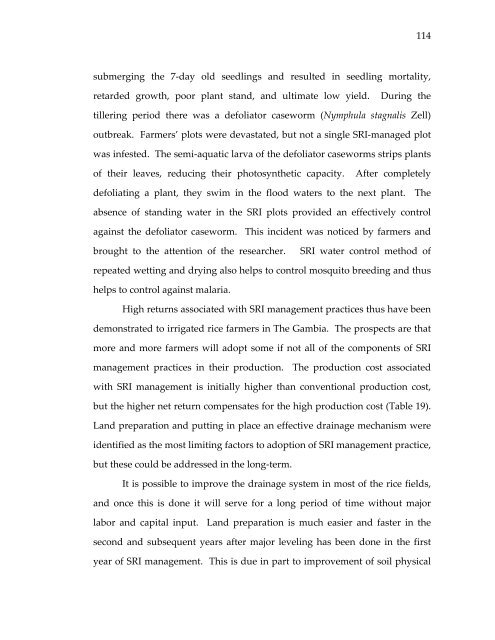Management of rice production systems to increase productivity
Management of rice production systems to increase productivity
Management of rice production systems to increase productivity
You also want an ePaper? Increase the reach of your titles
YUMPU automatically turns print PDFs into web optimized ePapers that Google loves.
submerging the 7‐day old seedlings and resulted in seedling mortality,<br />
retarded growth, poor plant stand, and ultimate low yield. During the<br />
tillering period there was a defolia<strong>to</strong>r caseworm (Nymphula stagnalis Zell)<br />
outbreak. Farmers’ plots were devastated, but not a single SRI‐managed plot<br />
was infested. The semi‐aquatic larva <strong>of</strong> the defolia<strong>to</strong>r caseworms strips plants<br />
<strong>of</strong> their leaves, reducing their pho<strong>to</strong>synthetic capacity. After completely<br />
defoliating a plant, they swim in the flood waters <strong>to</strong> the next plant. The<br />
absence <strong>of</strong> standing water in the SRI plots provided an effectively control<br />
against the defolia<strong>to</strong>r caseworm. This incident was noticed by farmers and<br />
brought <strong>to</strong> the attention <strong>of</strong> the researcher. SRI water control method <strong>of</strong><br />
repeated wetting and drying also helps <strong>to</strong> control mosqui<strong>to</strong> breeding and thus<br />
helps <strong>to</strong> control against malaria.<br />
114<br />
High returns associated with SRI management practices thus have been<br />
demonstrated <strong>to</strong> irrigated <strong>rice</strong> farmers in The Gambia. The prospects are that<br />
more and more farmers will adopt some if not all <strong>of</strong> the components <strong>of</strong> SRI<br />
management practices in their <strong>production</strong>. The <strong>production</strong> cost associated<br />
with SRI management is initially higher than conventional <strong>production</strong> cost,<br />
but the higher net return compensates for the high <strong>production</strong> cost (Table 19).<br />
Land preparation and putting in place an effective drainage mechanism were<br />
identified as the most limiting fac<strong>to</strong>rs <strong>to</strong> adoption <strong>of</strong> SRI management practice,<br />
but these could be addressed in the long‐term.<br />
It is possible <strong>to</strong> improve the drainage system in most <strong>of</strong> the <strong>rice</strong> fields,<br />
and once this is done it will serve for a long period <strong>of</strong> time without major<br />
labor and capital input. Land preparation is much easier and faster in the<br />
second and subsequent years after major leveling has been done in the first<br />
year <strong>of</strong> SRI management. This is due in part <strong>to</strong> improvement <strong>of</strong> soil physical
















